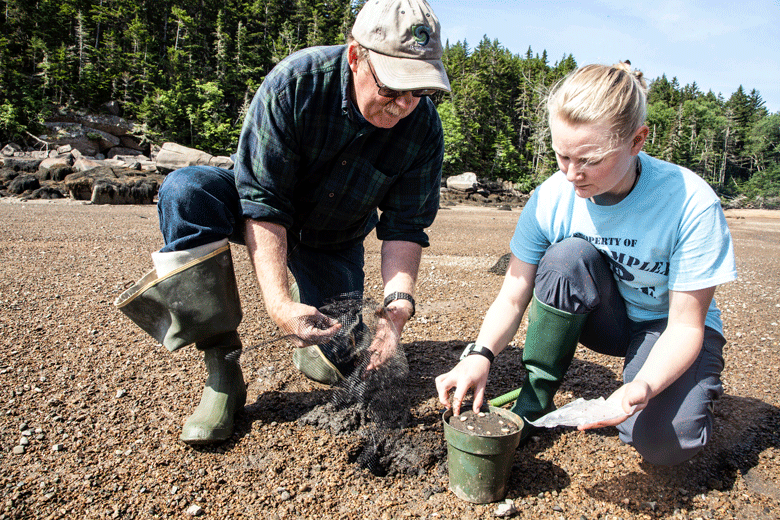Summer in Maine brings hungry vacationers seeking lobster rolls, blueberry pie, and the iconic softshell clam—fried, steamed, or in chowder. Clam prices are spiking in response to demand and hundreds of Maine clammers are working to meet it while the market is hot.
“I figure I’ll make 75% to 80% of my yearly income between June and October,” says David Cale, who clams in Machiasport, where he also serves on the town’s shellfish committee.
By value, softshell clams are Maine’s second largest fishery behind lobster. They’re a distant second but drew a respectable $25 million into the Maine economy last year.
We’re seeing higher summer temperatures and milder winters … formulas for disaster for the clam populations.”
There was a time when Maine’s clammers brought in much, much more. In 1977, they landed 7.8 million pounds, compared to 1.5 million pounds last year. The numbers fluctuate across the decades, but the overall trajectory is down.
“The landings data are very scary,” says Brian Beal, a marine ecology professor at the University of Maine at Machias and director of Research at the Downeast Institute. Beal clammed his way through high school and college and remembers when the harvest was better.
“If this were the pulp industry, or the lobster industry that experienced the loss of this many jobs, it would be a hue and cry,” says Beal. “But it’s just the lowly clam.”
Ask the reason for the softshell clam’s decline, and Beal does not hesitate.
“It’s warming water. We’re seeing higher and higher summer temperatures and we’re getting milder winters,” says Beal. “Those are formulas for disaster for the clam populations.”
Warming waters are a disaster for clams because they’re a boon for invertebrates like green crabs, its most successful predator. Green crabs arrived in Maine more than 100 years ago and today are wreaking havoc on softshell clam populations even before they’re visible to the human eye.
“Green crabs are the consummate invader,” says Beal. “They have a thermal tolerance that goes from zero degrees Celsius to 35 degrees Celsius,” or 32 to 95 Fahrenheit. “They can live underwater, they can live on mudflats, they can live under the mud, and they can eat anything from grass to clams to worms, to each other.”
Even in the midst of the invasion, there are places where clams are still doing well. Brunswick landed the most clams last year, followed by Waldoboro and Machiasport, a tiny Washington County fishing village where clamming is a way of life, and where Cale found his way to clamming later than most, at the ripe old age of 19.
“I was a late bloomer,” said Cale, now 46, and not entirely joking. “As a kid, a lot of my younger friends were out digging clams, but I didn’t have a lot of fishermen in my family.”
It’s a stunning summer day and Cale and his brother-in-law Josh Torgan are loading their rollers—some of us might call them clam baskets—into Cale’s skiff, preparing to back into Little Kennebec Bay.
Not all Downeast clammers use skiffs to access the flats, but it makes the most sense for Cale and Torgan because they’re pullers, not diggers. This means that instead of a digging clams out of the mud with a hoe, they pull them out of the mud by gloved hand.
You can’t pull clams close to shore because the mud is thick and heavy with gravel, so pullers work further away from the beach in areas more easily accessible by boat.
Today is a small tide, only 8 feet, which means the men will be pulling underwater.
“You have to work ahead of the cloud,” says Torgan, referring to the silty mud kicked up as they walk and pull their way across the bottom. The cloud obscures their ability to spot the elliptical clam holes dotting the mud all around them.
Not far away, a family is digging their clams just below the beach, also known as the upper intertidal zone. Most Maine towns have their highest concentration of clams there, says Beal, because it spends less time underwater, giving green crabs less time to feed. But Machiasport is unusual because it also has plentiful clams in the mid and lower intertidal, where Cale and Torgan are clamming today.
They make walking through the mud look easy, and it isn’t. Leaning forward over a bent knee the other leg behind them for balance, they bob up and down as they go, quickly sliding a hand in and out of the mud, tossing clams into their roller.
Clams must be at least 2 inches long to be legal in Maine, but there’s no upper size limit on clams, unlike for lobster, because the crustacean is more fertile as it ages.
Beal has long suspected clam reproduction functions the same way, and now he’ll have the chance to find out. Building on a promising pilot study, this year DEI secured a $300,000 grant from the National Marine Fisheries Service Saltonstall-Kennedy Program. Using the funds, they’ve designed a two-year study that will look at clam fecundity while asking three key questions—when do clams spawn, does their position in the intertidal zone affect their fertility, and does size matter?
If the study confirms Beal’s hypothesis, towns could use that information to plan short flat closures during spawning time, or the state might set an upper size limit on the fishery.
Beal is passionate about supporting clammers and the clam fishery with data, but says what happens after that is out of his hands.
“We’re just asking questions that people have been asking since the 1930s and ‘40s, and no one’s answered them yet,” says Beal. “If this study confirms what the pilot study said, now no one will say, ‘We don’t have the data.’ And if it doesn’t, we went down a path we shouldn’t have, but we never have to go down that path again.”





